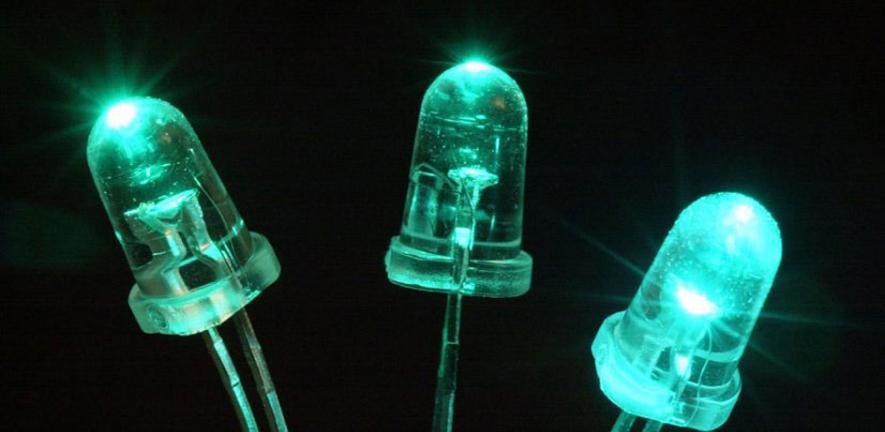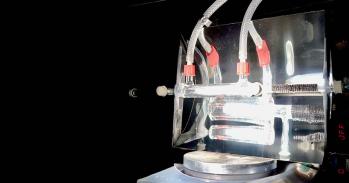
A remarkable light-emitting material, gallium nitride, could slash electricity consumption, purify water and kill superbugs.
A remarkable light-emitting material, gallium nitride, could slash electricity consumption, purify water and kill superbugs.
In the UK, lighting consumes over a fifth of all the electricity generated at power stations, and GaN LEDs have the potential to reduce this figure by at least 50% and possibly by 75%.
A revolution in lighting is under way. Thanks to advances in the technology, efficiency and cost of light-emitting diodes (LEDs), these devices are ready to take over in the very near future from conventional forms of incandescent lighting. The potential energy savings are huge: statistics from the US Department of Energy estimate that, by 2025, solid-state lighting such as LEDs could reduce the global amount of electricity used for lighting by 50% and, in the US alone, could eliminate 258 million metric tons of carbon emission, alleviate the need for 133 new power stations, and result in cumulative financial savings of over a hundred billion dollars. At the forefront of research underpinning this new lighting paradigm is a focus on the semiconductor gallium nitride (GaN) at the Cambridge Centre for Gallium Nitride in the Department of Materials Science and Metallurgy.
Why use GaN for LEDs?
LEDs based on GaN, which emits brilliant light when electricity is passed through it, are extremely energy efficient and long lasting. Traditional incandescent light bulbs are only 5% efficient at converting the electricity they consume into light, and, although low-energy light bulbs are 20% efficient, they contain hazardous mercury. Compare this with white GaN LEDs, which are already 30% efficient and have a target efficiency of 60%. GaN LEDs are also incredibly long lasting: an LED can burn for 100,000 hours. In practical terms, this means it only needs replacing after 60 years of typical household use.
In the UK, lighting consumes over a fifth of all the electricity generated at power stations, and GaN LEDs have the potential to reduce this figure by at least 50% and possibly by 75%.
The Holy Grail for GaN is home and office lighting. Research directed at reducing manufacturing costs and improving the quality of light is bringing this goal closer.
Materials and devices
Research at the Cambridge Centre for Gallium Nitride, directed by Professor Colin Humphreys, the Director of Research in the Department of Materials Science and Metallurgy, stretches from fundamental materials studies through to applications and devices.
The Centre has world-class GaN growth and characterisation facilities and has recently developed an innovative technique for growing GaN on large silicon wafers, instead of the more expensive sapphire wafers; this could deliver a tenfold reduction in LED manufacturing costs. The Centre is also working on improving the quality of light by coating blue LEDs with phosphors to produce white light. This will be improved still further through the use of novel phosphors produced by Professor Tony Cheetham in the Department of Materials Science and Metallurgy.
The future
GaN LEDs have hit the market rapidly and are already widely used in flashlights and front bicycle lights, as backlighting for mobile phones and interior lighting in cars and aeroplanes, and even to light up landmarks such as the façade of Buckingham Palace and the length of the Severn Bridge. Looking ahead, the timescale for the widespread adoption of GaN LEDs in homes and offices is probably as short as 5–10 years.
Other applications also look promising. Research at the Centre is investigating the possibility of using GaN LEDs to mimic sunlight, which could have important benefits for sufferers of seasonal affective disorder (SAD). And other studies are investigating how UV LEDs, created by adding aluminium to GaN, could be used for killing bacteria and stopping viruses from reproducing, either to purify water in the developing world or to ‘sweep’ hospital wards to eradicate superbugs.
For more information, please contact the author Professor Colin Humphreys (colin.humphreys@msm.cam.ac.uk) at the Cambridge Centre for Gallium Nitride. The Centre’s research is funded by the Engineering and Physical Sciences Research Council (EPSRC), the Technology Strategy Board (TSB), Aixtron Ltd, Sharp Electronics Europe, QinetiQ, Forge Europa, Philips, Imago Scientific Instruments and RFMD (UK) Ltd, and is performed in collaboration with the University of Manchester and Sheffield Hallam University.
This work is licensed under a Creative Commons Licence. If you use this content on your site please link back to this page.





